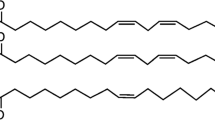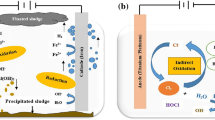Abstract
This work studies the efficiency of an electroflotation process for the separation of the solids produced during the electrocoagulation treatment of three different types of wastewater: kaolin suspension, coloured organic solution and oil-in-water emulsion. Additionally, a combined electrocoagulation-electroflotation reactor is designed and optimized taking into account the effect of current density, residence time, pollutant concentration and the ratio floated/settled solids. To do this, an experimental design with response surface methodology (RSM) has been used. Results show that electroflotation is a good alternative to the removal of oil microdrops and dyes, but it is not recommended for the separation of solids formed during electrocoagulation of colloid suspensions due to its high density. It has been found that the use of aluminium leads to better results than the use of iron in the treatment of oil-in-water emulsions and coloured solutions. In these cases, the use of a combined electrocoagulation-electroflotation reactor is recommended and the effect of the main inputs has been studied.










Similar content being viewed by others
References
Ahmed N, Jameson GJ (1985) The effect of bubble-size on the rate of flotation of fine particles. Int J Miner Process 14:195–215
Bonilla CF (1947) Possibilities of electronic coagulator for water treatment. Water sewage 85:44–45
Canizares P, Martinez F, Jimenez C, Lobato J, Rodrigo MA (2006) Coagulation and electrocoagulation of wastes polluted with dyes. Environ Sci Technol 40:6418–6424
Canizares P, Jimenez C, Martinez F, Saez C, Rodrigo MA (2007a) Study of the electrocoagulation process using aluminum and iron electrodes. Industrial & Eng Chem Research 46:6189–6195
Canizares P, Martinez F, Jimenez C, Lobato J, Rodrigo MA (2007b) Coagulation and electrocoagulation of wastes polluted with colloids. Sep Sci Technol 42:2157–2175
Canizares P, Martinez F, Jimenez C, Saez C, Rodrigo MA (2008) Coagulation and electrocoagulation of oil-in-water emulsions. J Hazard Mater 151:44–51
Chavalparit O, Ongwandee M (2009) Optimizing electrocoagulation process for the treatment of biodiesel wastewater using response surface methodology. J Environ Sci-China 21:1491–1496
Chen GH (2004) Electrochemical technologies in wastewater treatment. Sep Purif Technol 38:11–41
Clesceri LSGAEEl, American Public Health A, Water Environment F, American Water Works A (1998) Standard methods for the examination of water and wastewater. American Public Health Association, Washington
Essadki AH, Gourich B, Vial C, Delmas H, Bennajah M (2009) Defluoridation of drinking water by electrocoagulation/electroflotation in a stirred tank reactor with a comparative performance to an external-loop airlift reactor. J Hazard Mater 168:1325–1333
Gurses A, Yalcin M, Dogar C (2002) Electrocoagulation of some reactive dyes: a statistical investigation of some electrochemical variables. Waste Manag 22:491–499
Holt PK, Barton GW, Wark M, Mitchell CA (2002) A quantitative comparison between chemical dosing and electrocoagulation. Colloids and Surfaces a-Physicochemical and Eng Aspects 211:233–248
Hosny AY (1992) Separation of oil from oil/water emulsions using an electroflotation cell with insoluble electrodes. Filtration & Separation 29:419–423
Jimenez C, Talavera B, Saez C, Canizares P, Rodrigo MA (2010) Study of the production of hydrogen bubbles at low current densities for electroflotation processes. J Chem Technol Biotechnol 85:1368–1373
Jimenez C, Saez C, Martinez F, Canizares P, Rodrigo MA (2012) Electrochemical dosing of iron and aluminum in continuous processes: a key step to explain electro-coagulation processes. Sep Purif Technol 98:102–108
Ketkar DR, Mallikarjunan R, Venkatachalam S (1991) Electroflotation of quartz fines. Int J Miner Process 31:127–138
Khemis M, Leclerc JP, Tanguy G, Valentin G, Lapicque F (2006) Treatment of industrial liquid wastes by electrocoagulation: experimental investigations and an overall interpretation model. Chemical Eng Sci 61:3602–3609
Kobya M, Demirbas E, Bayramoglu M, Sensoy MT (2011) Optimization of electrocoagulation process for the treatment of metal cutting wastewaters with response surface methodology. Water Air Soil Pollut 215:399–410
Korbahti BK, Artut K (2013) Bilge water treatment in an upflow electrochemical reactor using Pt anode. Sep Sci Technol 48:2204–2216
Korbahti BK, Tanyolac A (2008) Electrochemical treatment of simulated textile wastewater with industrial components and Levafix Blue CA reactive dye: optimization through response surface methodology. J Hazard Mater 151:422–431
Korbahti BK, Artut K, Gecgel C, Ozer A (2011) Electrochemical decolorization of textile dyes and removal of metal ions from textile dye and metal ion binary mixtures. Chem Eng J 173:677–688
Merzouk B, Madani K, Sekki A (2010) Using electrocoagulation-electroflotation technology to treat synthetic solution and textile wastewater, two case studies. Desalination 250:573–577
Mollah MYA, Schennach R, Parga JR, Cocke DL (2001) Electrocoagulation (EC)—science and applications. J Hazard Mater 84:29–41
Rajeshwar JG, Ibañez K (1997) Environmental electrochemistry, fundamentals and applications in pollution abatement. Academic Press, London, UK
Raju GB, Khangaonkar PR (1984) Electroflotation—a critical-review. Transactions of the Indian Institute of Metals 37:59–66
Strokach PP (1975) The prospects of using anodic dissolution of metal for water purification. Electrochem Ind Processing Bio Electrochem Ind Process Bio 55:375
Stuart EE (1946) Electronic water purification progress report on the electronic coagulator—a new device which gives promise of unusually speedy and effective results. Water Sewage 84:24–26
Tir M, Moulai-Mostefa N (2008) Optimization of oil removal from oily wastewater by electrocoagulation using response surface method. J Hazard Mater 158:107–115
Zodi S, Potier O, Lapicque F, Leclerc J-P (2009) Treatment of the textile wastewaters by electrocoagulation: effect of operating parameters on the sludge settling characteristics. Sep Purif Technol 69:29–36
Zodi S, Potier O, Lapicque F, Leclerc J-P (2010) Treatment of the industrial wastewaters by electrocoagulation: optimization of coupled electrochemical and sedimentation processes. Desalination 261:186–190
Zodi S, Potier O, Merzouk B, Lapicque F, Leclerc J-P (2013) Direct red 81 dye removal by a continuous flow electrocoagulation/flotation reactor. Sep Purif Technol 108:215–222
Zongo I, Leclerc J-P, Maiga HA, Wethe J, Lapicque F (2009a) Removal of hexavalent chromium from industrial wastewater by electrocoagulation: a comprehensive comparison of aluminium and iron electrodes. Sep Purif Technol 66:159–166
Zongo I, Maiga AH, Wethe J, Valentin G, Leclerc J-P, Paternotte G, Lapicque F (2009b) Electrocoagulation for the treatment of textile wastewaters with Al or Fe electrodes: compared variations of COD levels, turbidity and absorbance. J Hazard Mater 169:70–76
Acknowledgments
The authors acknowledge funding support from the EU and Spanish Government through the MINECO Project CTM2013-45612-R, FEDER 2007–2013 PP201010 (Planta Piloto de Estación de Estación de Regeneración de Aguas Depuradas) and INNOCAMPUS
Author information
Authors and Affiliations
Corresponding author
Additional information
Responsible editor: Bingcai Pan
Highlights
- Combined electrocoagulation-electroflotation is very efficient for low-density flocs.
- Aluminium electrocoagulation leads to better electroflotation of oil-in-water emulsions than iron electrocoagulation.
- Removal of dye flocs by electroflotation is faster when aluminium is used as coagulant but the total removal attained is comparable to that obtained with iron.
- Electrocoagulation and electroflotation can be successfully combined in a single prototype.
- RSM models successfully the results obtained in a combined electrocoagulation-electroflotation reactor.
Electronic supplementary material
Below is the link to the electronic supplementary material.
ESM 1
(DOCX 99 kb)
Rights and permissions
About this article
Cite this article
Jiménez, C., Sáez, C., Cañizares, P. et al. Optimization of a combined electrocoagulation-electroflotation reactor. Environ Sci Pollut Res 23, 9700–9711 (2016). https://doi.org/10.1007/s11356-016-6199-y
Received:
Accepted:
Published:
Issue Date:
DOI: https://doi.org/10.1007/s11356-016-6199-y




